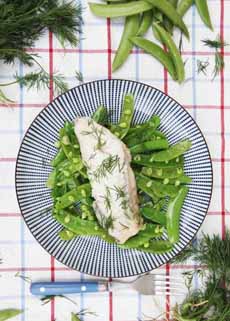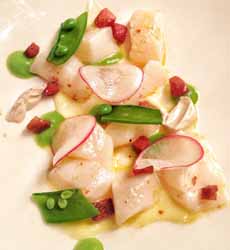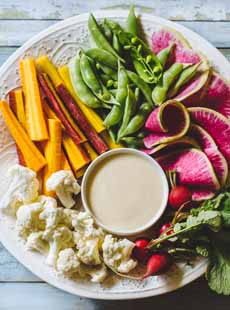TIP OF THE DAY: Sugar Snap Peas
|
Look in the produce section for sugar snap peas, a spring treat. Sugar snap peas, sometimes just called sugar peas or snap peas, are edible-podded peas, meaning that you eat the whole pod. They can be distinguished from another popular edible pod, snow peas, in that their pods are rounded and firm as opposed to flat and thin. Both varieties can be cooked or eaten raw. Why can you eat the pods of these, but not of the English or garden pea? Edible-podded peas do not have a membrane and do not open when ripe. The pods are less fibrous, and the peas are harvested when young making them an even easier chew. While peas are one of the oldest cultivated foods, beginning some 10,000 years ago (the history of peas), sugar snap peas are a relatively new variety. The flat snow peas have been grown in the west since the 19th century, but sugar snap peas were only developed in 1952. Snow peas were cross-bred with a mutant shell pea plant by Drs. Calvin Lamborn and M.C. Parker of Twin Falls, Idaho. Voilà: a new class of snow pea, Pisum sativum var. macrocarpon, a.k.a. the sugar snap pea. If you’re a frequent reader of THE NIBBLE, you may recall that the botanical definition of a fruit is a plant that carries its seeds inside. An apple is a fruit: The seeds are inside. Celery is a vegetable: It has no seeds inside*. There are a number of fruits that we consider to be vegetables, including bell peppers, cucumbers, eggplants, okra, squash, tomatoes and tree fruits like avocado and olives†… …and all varieties of peas in a pod, known in the industry as pod fruits. At just 41 calories per cup, sugar snap peas fit into virtually any eating plan, including low-carb and low-calorie diets. They are a very good source of vitamins A and C and a good source of iron. They remain crunchy even when cooked, so crunch away! ________________ *Rather than eating the fruit of the plant, which has the seeds inside, the vegetables we eat are different parts of plants. For example, spinach and cabbage are leaves of the plant, asparagus and celery are stems, beets and carrots are roots. None of these vegetable parts contain seeds. †These plants are the non-sweet fruits of flowering plants. They carry their seeds inside because they evolved as seed-bearing structures. A “seedless” fruit is a fruit is one that has been modified so that its seeds are soft and can be chewed easily (e.g. a seedless watermelon). Or, they have the seeds that fail to develop. |
 [1] Sugar snap peas sauteed with Meyer lemon and mint. Here’s the recipe from The Kitchn..
|
|
|
|
||





